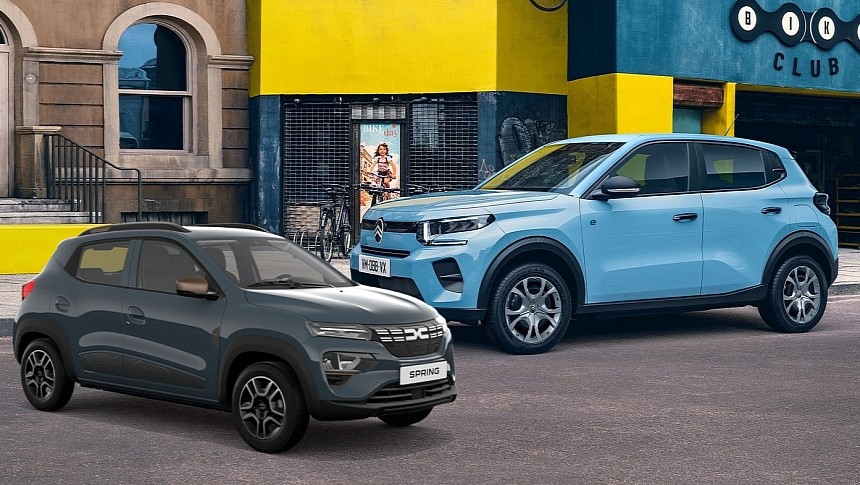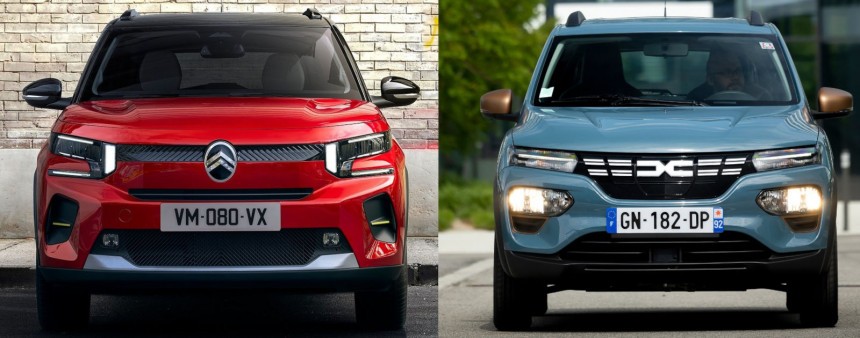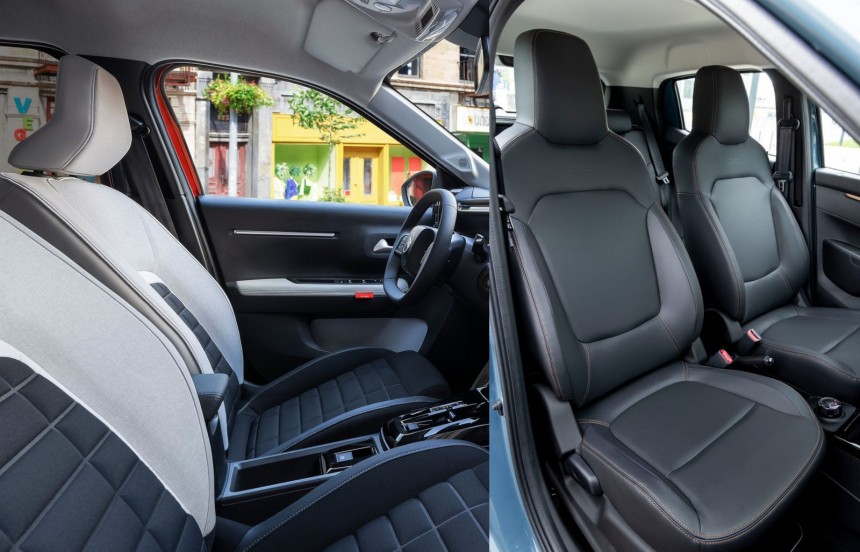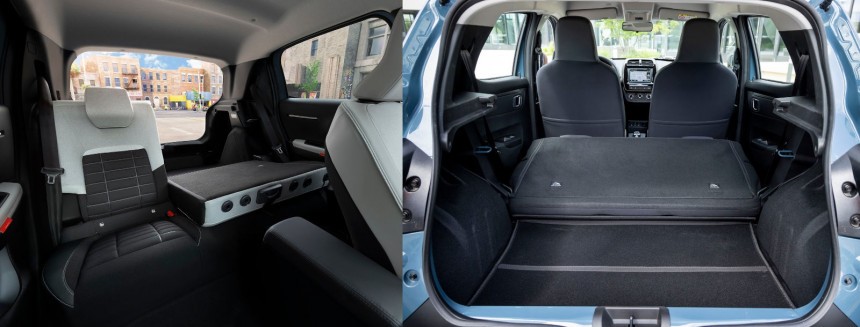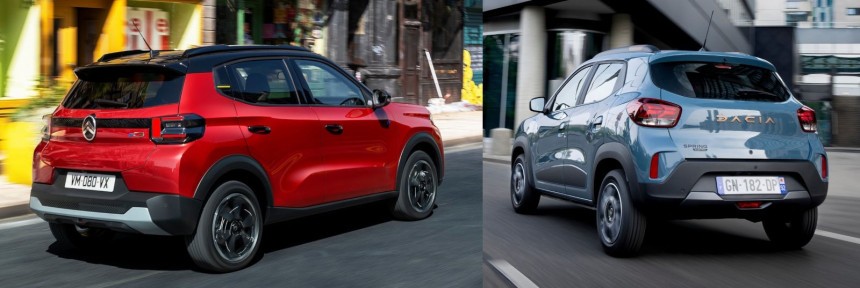I have owned my Spring for almost two years and more than 20,000 km / 12,500 miles. Up to this point, there were more pros than cons. But recently, Stellantis surprised me by announcing the closest contender yet for the electric Dacia.
So, naturally, a question arose: should I ditch my cheap Chinese-made European-low-cost-Dacia branded small-battery, low-range city electric car for a less-cheap European-made not-so-small-battery, not-so-low-range bigger electric vehicle?
The safety of my kid in the back is my top priority, of course. Still, I'm not willing to use this as an excuse for trading a non-polluting, practical little city car for a big guzzler, much more expensivetank SUV, impractical on the narrow streets and for the parking spaces in the city.
Still, a wider car means more safety, especially in side-collision situations. The Citroen e-C3 is better than the Spring: its width is 1.8 m / 70.8 in, while Spring's is less than 1.6 m / 63 in. The surplus of 10 cm / 4 in of safety on my kid's side is a strong argument for the e-C3.
By the way, the e-C3 is actually as large as a Dacia Sandero Stepway, so it's expected to provide much better overall safety for all occupants. Spring is basically a battery-converted and marginally safety-improved Renault Kwid.
The petrol variant of the Kwid sold in India and South America doesn't pass Euro-NCAP safety tests. It's food for thought and a compromise that is hard to live with when having kids. At least I'm among the most cautious drivers on the road.
The Citroen e-C3 promises much more comfortable Advanced Comfort seats, more ergonomic and with extra padding. Of course, I can't rely only on marketing promises and lovely photos; I must try those seats myself. Oh, and don't forget the separate headrests, which look more comfortable and safer for the neck than Spring's recessed headrests.
On the other hand, I can't omit these Advanced Comfort seats are only available on the more expensive trim level of the e-C3. So, I wonder if the seats in the basic trim level are better than the Spring's or if they follow the same cheap recipe.
At least Citroen's seat upholstery I expect to be more convenient than that almost horrible artificial leather in Spring. It's too damn hot in the summer, while my buttock is simply freezing on cold days. Unfortunately, when I ordered the car three years ago, I didn't have the option to choose other seats.
The e-C3 also has a one-piece foldable bench backrest in the basic trim level, but the next one provides the splitting backrest as standard. The 60:40 configuration is convenient, and there were more instances when I needed it than I expected with Spring.
I find this a much more important feature than e-C3 having a larger boot than Spring. The 270 liters / 9.5 cubic feet boot for a 2+2 passenger car is outstanding, while the 310 liters / 11 cubic feet boot for a small 4-meter / 13-feet crossover is a good value but not out of the ordinary.
A simple comparison between the main battery specs of the two cars only tells part of the story.
Spring's battery has a low-performance ternary lithium-ion "old recipe," credited with good energy density and high charge and discharge efficiency. At the same time, it has low resistance to high or very low temperatures and is prone to rapid degradation in intensive fast-charging usage.
That's why Spring's fast-charging capability is limited to only 30 kWh, and its most potent electric motor has only 48 kW (65 HP). I charge my Spring almost entirely at home, at night, with a 220V outlet, and I try to drive with moderate acceleration to keep the battery degradation low.
After 20,000 km / 12.5 miles and two years, my car's battery's SoH (State-of-Health) value has fallen to around 96%, which is pretty good. I bet I can easily go past the 8-year warranty for the SoH remaining over 75%, and there's a good chance that I can use the car for probably 15 years until the battery is depleted. Still, I expect higher charging times and significantly lower ranges as the degradation advances.
The e-C3's battery is the LFP type – Lithium iron phosphate, or LiFePO4. It's also kind of an "old recipe," credited with low energy density, low charge and discharge efficiency, and poor performance at low temperatures.
On the other hand, the main advantages are high temperature resistance, high safety stability, low price, and better cycle performance. It's also lighter in weight, allows for faster charging, provides a longer lifespan, and is more environmentally friendly.
To sum it up, the LFP battery in the new Citroen e-C3 is simply better than the ternary in Dacia Spring. It allows for a more performant electric motor and up to 100 kW fast-charging – three times more than Spring! While these two features are not crucial for my usage pattern, they can't be ignored when considering the price factor.
The less-than-ten-grand euro Spring looks like the best offer – and it is if I ignore all the details of living with it on a day-by-day basis. But considering all the factors above, the better bang for the buck is the Citroen e-C3.
The 2,500 euros / 2.650 USD difference between the two cars translates into the e-C3 being only 12% more expensive than the basic Spring. For sure, the plus in terms of better safety, more comfort, and superior technology is worth paying that extra money.
Things change a little when comparing the subsidized prices: the e-C3 is 25% more expensive that way. It may be too much for someone willing to make significant compromises in return for an under-ten-thousand kind-of-utilitarian-EV.
Today, if I were to go for a Spring, I would choose the more expensive Extreme trim level instead of the basic Essential. It would cost me €11,400 / $12,100, including subsidies, which is only 850 euros / 900 USD more than the better basic e-C3.
I'm sure I'd be more inclined towards the e-C3, and I'm eager to find out how expensive the superior Max trim level will be. It will surely be less than €30,000 / $31,800 before incentives, but how close to the twenty-five-grand euros?
However, the real question here is…
Stellantis is confident that this new EV, and the future ones that will use the same underpinning, will counter the Chinese invasion of affordable and cheap electric cars. The Citroen e-C3 will be manufactured in European Slovakia, which is a bonus if you don't trust "Made in China" cars.
But I already own, drive, and enjoy the advantages of a little electric car. I remember I waited almost a year for my car to arrive at the dealership after I paid the reservation. Things will mostly stay the same with the e-C3, as I forecast a long waiting list from Europeans.
So, if I make a reservation today, my e-C3 will probably be available somewhere the following summer, in the best-case scenario. Today, I can still sell my two-year-old and 20,000 km Spring for around €10,000 / $10,600, but what am I supposed to use for my daily commute if I sell it now?
By next summer, it will be close to 30,000 km, and its resale value, I suspect, will be less than 8,000 euros / 8,500 USD. This is okay, considering I paid a little over this amount when it was new. So, for the new Citroen e-C3, I'd actually have to get an extra 4,500-5,000 euros / 4,700-5,300 USD after selling the used Spring.
But, as always, don't ignore the bigger picture: the competition. Stellantis will use the e-CMP platform – derived from the one designed for the Indian market (funny, Kwid was also developed in India) – for other models from the brands in its portfolio, such as Opel, Fiat, and Peugeot.
Next year, it seems that Renault will make significant improvements to the Spring to keep up the pace, and don't forget the new EVs in the pipeline. Volkswagen Group has big plans for sub-30,000 euros electric vehicles for the European market, and I suspect the e-Up! successor is worth waiting for.
Ford, Hyundai-KIA, or Toyota are expected to jump in the affordable EV wagon very soon, as the industry is worried about Chinese brands flooding the European market with cheap EVs. I expect several competitors for the Spring by 2025 and a fierce battle.
And that's why I'll keep my Spring for now, despite being "Made in China," the poor safety level, or the inferior battery tech. At this point, while far from perfect, it's the perfect car for me and my needs. At least for a couple of years from now.
With 234 mm / 9.2 in more in width, the e-C3 is safer for my kid
I take my less-than-five-year-old daughter to kindergarten every day in the Spring. It's a 32 km / 20-mile trip on roads, highways (half of the distance), and city-congested traffic. Almost every day, some moron drives dangerously close to me, and I must be vigilant to avoid collisions.The safety of my kid in the back is my top priority, of course. Still, I'm not willing to use this as an excuse for trading a non-polluting, practical little city car for a big guzzler, much more expensive
Still, a wider car means more safety, especially in side-collision situations. The Citroen e-C3 is better than the Spring: its width is 1.8 m / 70.8 in, while Spring's is less than 1.6 m / 63 in. The surplus of 10 cm / 4 in of safety on my kid's side is a strong argument for the e-C3.
The petrol variant of the Kwid sold in India and South America doesn't pass Euro-NCAP safety tests. It's food for thought and a compromise that is hard to live with when having kids. At least I'm among the most cautious drivers on the road.
Any other seat is better than Spring's seats
On my daily commute, I drive around 65 km / 40 miles, and I spend a total of about 4 hours behind the wheel. That's too much time sitting in the uncomfortable driver's seat in the Spring, especially for someone with spine problems – yep, that's me; take notes and avoid (too much) sedentariness…The Citroen e-C3 promises much more comfortable Advanced Comfort seats, more ergonomic and with extra padding. Of course, I can't rely only on marketing promises and lovely photos; I must try those seats myself. Oh, and don't forget the separate headrests, which look more comfortable and safer for the neck than Spring's recessed headrests.
At least Citroen's seat upholstery I expect to be more convenient than that almost horrible artificial leather in Spring. It's too damn hot in the summer, while my buttock is simply freezing on cold days. Unfortunately, when I ordered the car three years ago, I didn't have the option to choose other seats.
The 60:40 splitting backrest of the backseat
Because Spring is a little car for only four passengers and is a very cheap car, the bench backrest can be folded only in one piece. That was fine and pretty easy to handle when I needed to expand the surprisingly spacious boot, but it's useless when having a child seat in the back.The e-C3 also has a one-piece foldable bench backrest in the basic trim level, but the next one provides the splitting backrest as standard. The 60:40 configuration is convenient, and there were more instances when I needed it than I expected with Spring.
The LFP battery promises to be more reliable
The Spring has a 27.4-kWh net (usable) capacity battery pack, providing a WLTP range of 230 km / 143 miles. The e-C3 has a 44-kWh gross (total) capacity battery pack, providing a WLTP range of 320 km / 199 miles. So, Citroen is better, but wait a second.A simple comparison between the main battery specs of the two cars only tells part of the story.
That's why Spring's fast-charging capability is limited to only 30 kWh, and its most potent electric motor has only 48 kW (65 HP). I charge my Spring almost entirely at home, at night, with a 220V outlet, and I try to drive with moderate acceleration to keep the battery degradation low.
After 20,000 km / 12.5 miles and two years, my car's battery's SoH (State-of-Health) value has fallen to around 96%, which is pretty good. I bet I can easily go past the 8-year warranty for the SoH remaining over 75%, and there's a good chance that I can use the car for probably 15 years until the battery is depleted. Still, I expect higher charging times and significantly lower ranges as the degradation advances.
The e-C3's battery is the LFP type – Lithium iron phosphate, or LiFePO4. It's also kind of an "old recipe," credited with low energy density, low charge and discharge efficiency, and poor performance at low temperatures.
On the other hand, the main advantages are high temperature resistance, high safety stability, low price, and better cycle performance. It's also lighter in weight, allows for faster charging, provides a longer lifespan, and is more environmentally friendly.
To sum it up, the LFP battery in the new Citroen e-C3 is simply better than the ternary in Dacia Spring. It allows for a more performant electric motor and up to 100 kW fast-charging – three times more than Spring! While these two features are not crucial for my usage pattern, they can't be ignored when considering the price factor.
A difference of only 2,500 euros / 2.650 USD? Shut up and take my mo…
The cheapest Dacia Spring in Europe starts from €20,800 / $22,000, while the base price for the new Citroen e-C3 is €23,300 / $24,700. In my country, thanks to generous government incentives for EVs, these two cars start from €9,750 / $10,300 for Spring and €12,250 / $13,000 for e-C3, respectively.The less-than-ten-grand euro Spring looks like the best offer – and it is if I ignore all the details of living with it on a day-by-day basis. But considering all the factors above, the better bang for the buck is the Citroen e-C3.
Things change a little when comparing the subsidized prices: the e-C3 is 25% more expensive that way. It may be too much for someone willing to make significant compromises in return for an under-ten-thousand kind-of-utilitarian-EV.
Today, if I were to go for a Spring, I would choose the more expensive Extreme trim level instead of the basic Essential. It would cost me €11,400 / $12,100, including subsidies, which is only 850 euros / 900 USD more than the better basic e-C3.
I'm sure I'd be more inclined towards the e-C3, and I'm eager to find out how expensive the superior Max trim level will be. It will surely be less than €30,000 / $31,800 before incentives, but how close to the twenty-five-grand euros?
However, the real question here is…
… will I trade my Spring for an e-C3? Not likely
If you want your next car to be an affordable electric city car, I advise you to go for the new Citroen e-C3 instead of the Dacia Spring. The e-C3 is the better option today, and many pros justify the convenient difference in price. That's my opinion.Stellantis is confident that this new EV, and the future ones that will use the same underpinning, will counter the Chinese invasion of affordable and cheap electric cars. The Citroen e-C3 will be manufactured in European Slovakia, which is a bonus if you don't trust "Made in China" cars.
But I already own, drive, and enjoy the advantages of a little electric car. I remember I waited almost a year for my car to arrive at the dealership after I paid the reservation. Things will mostly stay the same with the e-C3, as I forecast a long waiting list from Europeans.
So, if I make a reservation today, my e-C3 will probably be available somewhere the following summer, in the best-case scenario. Today, I can still sell my two-year-old and 20,000 km Spring for around €10,000 / $10,600, but what am I supposed to use for my daily commute if I sell it now?
By next summer, it will be close to 30,000 km, and its resale value, I suspect, will be less than 8,000 euros / 8,500 USD. This is okay, considering I paid a little over this amount when it was new. So, for the new Citroen e-C3, I'd actually have to get an extra 4,500-5,000 euros / 4,700-5,300 USD after selling the used Spring.
Next year, it seems that Renault will make significant improvements to the Spring to keep up the pace, and don't forget the new EVs in the pipeline. Volkswagen Group has big plans for sub-30,000 euros electric vehicles for the European market, and I suspect the e-Up! successor is worth waiting for.
Ford, Hyundai-KIA, or Toyota are expected to jump in the affordable EV wagon very soon, as the industry is worried about Chinese brands flooding the European market with cheap EVs. I expect several competitors for the Spring by 2025 and a fierce battle.
And that's why I'll keep my Spring for now, despite being "Made in China," the poor safety level, or the inferior battery tech. At this point, while far from perfect, it's the perfect car for me and my needs. At least for a couple of years from now.
